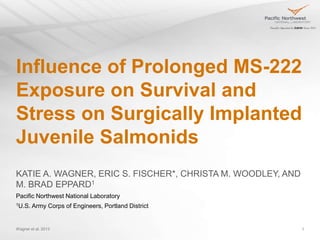2013 AFS Juvenile Chinook Prolonged Exposure to MS-222_Katie Wagner
- 1. Wagner et al. 2013 1 Influence of Prolonged MS-222 Exposure on Survival and Stress on Surgically Implanted Juvenile Salmonids KATIE A. WAGNER, ERIC S. FISCHER*, CHRISTA M. WOODLEY, AND M. BRAD EPPARD1 Pacific Northwest National Laboratory 1U.S. Army Corps of Engineers, Portland District
- 2. Background Large-Scale Telemetry Studies Survival and behavior Juvenile Salmon Acoustic Telemetry System Columbia River Basin 2012: upwards of 25,000 fish 2
- 3. Background: Surgical Process Pre-Surgery Anesthesia Tag assignment Condition Photographed Surgery Incision Tag insertion Incision Closure Recovery Wagner et al. 2013 3
- 4. Background: MS-222 Stage 4 (80 mg/L) Mechanism: Inhibits voltage-sensitive Na+ channels Use guidelines: Vague Max exposure (Argent 2011): 12 min @ 80-135 mg/L 30+ min @ 65 mg/L Columbia River Basin researchers up to 10 min Wagner et al. 2013 4 http://www.argent-labs.com
- 5. Objective To determine the stress responses (immediate and long-term) associated with extended MS-222 exposure for surgically implanted juvenile Chinook salmon. Anesthetic exposure alter performance over time? Mortality? Tag lossˇ Wagner et al. 2013 5
- 6. Methods: Study Design 3 Treatment Groups Anesthetic Control (AC) ¨C no anesthetic exposure or surgical implantation Surgical Control (SC) ¨C exposed to MS-222 until Stage 4 Induction; no surgical implantation Surgically Implanted (SI) ¨C exposed to MS-222 for varying time exposures; surgically implanted 0, 3, 5, 6, 9, 12, or 15 minutes past Stage 4 induction Wagner et al. 2013 6
- 7. Methods: Study Design Sample Days Day 0: AC versus SI Day 1, Day 7, Day 14: SC versus SI Measures Survival Tag Loss Analyte Concentration pH Cortisol Wagner et al. 2013 7
- 8. Results: Survival & Tag Loss 100% Survival No mortalities through post-exposure D14 0% Tag Loss No tag loss through post-exposure D14 Healing process was able to occur Wagner et al. 2013 8
- 9. AC 0 3 5 6 9 12 15 [Na+](mmolL-1) 90 100 110 120 130 140 150 160 170 AC 0 3 5 6 9 12 15 [Ca2+](mmolL-1) 0.0 0.5 1.0 1.5 2.0 AC 0 3 5 6 9 12 15 [K+](mmolL-1) 1 2 3 4 5 6 7 8 Time in MS-222 Past Stage 4 Induction (min) AC 0 3 5 6 9 12 15 pH 7.05 7.10 7.15 7.20 7.25 7.30 7.35 Time in MS-222 Past Stage 4 Induction (min) AC 0 3 5 6 9 12 15 Cortisol(ngmL-1) 0 50 100 150 200 250 Results: Day 0 Stress Wagner et al 2013 9
- 10. 0 3 5 6 9 12 15 [Na+](mmolL-1) 90 100 110 120 130 140 150 160 170 0 3 5 6 9 12 15 [Ca2+](mmolL-1) 0.0 0.5 1.0 1.5 2.0 0 3 5 6 9 12 15 [K+](mmolL-1) 1 2 3 4 5 6 7 8 Time in MS-222 Past Stage 4 Induction (min) 0 3 5 6 9 12 15 pH 7.10 7.15 7.20 7.25 7.30 7.35 Time in MS-222 Past Stage 4 Induction (min) 0 3 5 6 9 12 15 Cortisol(ngmL-1) 0 50 100 150 200 250 Results: Day 0 Stress Wagner et al. 2013 10
- 11. Results: Days 1 to 14 Stress Wagner et al. 2013 11 80 90 100 110 120 130 140 Day 1 Day 7 Day 14 [Na+](mmolL-1) SC SI 0 1 2 3 4 5 6 Day 1 Day 7 Day 14 [K+](mmolL-1) SC SI 0 0.5 1 1.5 2 Day 1 Day 7 Day 14 [Ca2+](mmolL-1) SC SI 7.05 7.1 7.15 7.2 7.25 7.3 Day 1 Day 7 Day 14 pH SC SI 0 20 40 60 80 100 120 140 Day 1 Day 7 Day 14Cortisol(ngmL-1) SC SI
- 12. Results: Patterns between days September 15, 2013 12 Time Spent in MS-222 Past Stage 4 Induction (min) 0 3 5 6 9 12 15 Sodium(mmolL -1 ) 90 100 110 120 130 140 150 Day 0 Day1 Day 7 Day 14 Time Spent in MS-222 Past Stage 4 Induction (min) 0 3 5 6 9 12 15 Sodium(mmolL -1 ) 90 100 110 120 130 140 150 Day 0 Day1 Day 7 Day 14
- 13. Time Spent in MS-222 Past Stage 4 Induction (min) 0 3 5 6 9 12 15 Calcium(mmolL -1 ) 0.0 0.2 0.4 0.6 0.8 1.0 1.2 Day 0 Day 1 Day 7 Day 14 Results: Patterns between days Wagner et al. 2013 13 Time Spent in MS-222 Past Stage 4 Induction (min) 0 3 5 6 9 12 15 Sodium(mmolL -1 ) 90 100 110 120 130 140 150 Day 0 Day1 Day 7 Day 14 Time Spent in MS-222 Past Stage 4 Induction (min) 0 3 5 6 9 12 15 Calcium(mmolL -1 ) 0.0 0.2 0.4 0.6 0.8 1.0 1.2 Day 0 Day 1 Day 7 Day 14
- 14. Results: Patterns between days Wagner et al. 2013 14 Time Spent in MS-222 Past Stage 4 Induction (min) 0 3 5 6 9 12 15 Sodium(mmolL -1 ) 90 100 110 120 130 140 150 Day 0 Day1 Day 7 Day 14 Time Spent in MS-222 Past Stage 4 Induction (min) 0 3 5 6 9 12 15 Calcium(mmolL -1 ) 0.0 0.2 0.4 0.6 0.8 1.0 1.2 Day 0 Day 1 Day 7 Day 14 Time Spent in MS-222 Past Stage 4 Induction (min) 0 3 5 6 9 12 15 Potassium(mmolL -1 ) 3.0 3.5 4.0 4.5 Day 0 Day 1 Day 7 Day 14 Time Spent in MS-222 Past Stage 4 Induction (min) 0 3 5 6 9 12 15 Potassium(mmolL -1 ) 3.0 3.5 4.0 4.5 Day 0 Day 1 Day 7 Day 14
- 15. Results: Patterns between days Wagner et al. 2013 15 Time Spent in MS-222 Past Stage 4 Induction (min) 0 3 5 6 9 12 15 Sodium(mmolL -1 ) 90 100 110 120 130 140 150 Day 0 Day1 Day 7 Day 14 Time Spent in MS-222 Past Stage 4 Induction (min) 0 3 5 6 9 12 15 Calcium(mmolL -1 ) 0.0 0.2 0.4 0.6 0.8 1.0 1.2 Day 0 Day 1 Day 7 Day 14 Time Spent in MS-222 Past Stage 4 Induction (min) 0 3 5 6 9 12 15 Potassium(mmolL -1 ) 3.0 3.5 4.0 4.5 Day 0 Day 1 Day 7 Day 14 Time Spent in MS-222 Past Stage 4 Induction (min) 0 3 5 6 9 12 15 pH 7.18 7.20 7.22 7.24 7.26 Day 0 Day 1 Day 7 Day 14 Time Spent in MS-222 Past Stage 4 Induction (min) 0 3 5 6 9 12 15 pH 7.18 7.20 7.22 7.24 7.26 Day 0 Day 1 Day 7 Day 14
- 16. Time Spent in MS-222 Past Stage 4 Induction (min) 0 3 5 6 9 12 15 Calcium(mmolL -1 ) 0.0 0.2 0.4 0.6 0.8 1.0 1.2 Day 0 Day 1 Day 7 Day 14 Time Spent in MS-222 Past Stage 4 Induction (min) 0 3 5 6 9 12 15 Sodium(mmolL -1 ) 90 100 110 120 130 140 150 Day 0 Day1 Day 7 Day 14 Time Spent in MS-222 Past Stage 4 Induction (min) 0 3 5 6 9 12 15 pH 7.18 7.20 7.22 7.24 7.26 Day 0 Day 1 Day 7 Day 14 Time Spent in MS-222 Past Stage 4 Induction (min) 0 3 5 6 9 12 15 Cortisol(ngmL -1 ) 80 90 100 110 120 130 140 150 Day 0 Day 1 Day 7 Day 14 Results: Patterns between days Wagner et al. 2013 16 Time Spent in MS-222 Past Stage 4 Induction (min) 0 3 5 6 9 12 15 Potassium(mmolL -1 ) 3.0 3.5 4.0 4.5 Day 0 Day 1 Day 7 Day 14 Time Spent in MS-222 Past Stage 4 Induction (min) 0 3 5 6 9 12 15 Cortisol(ngmL -1 ) 80 90 100 110 120 130 140 150 Day 0 Day 1 Day 7 Day 14
- 17. Summary Immediate responses (Day 0) Delayed cortisol release Resulted in osmotic disturbances variation in longer exposures Long-term responses (Days 1, 7, and 14) Na+, Ca2+, and pH over time Cortisol over time variation in longer exposures Wagner et al. 2013 17
- 18. Impacts on Field Studies Stress response levels not stabilized by release (18-24 hours) Longer MS-222 exposures Altered performance or behavior? Higher cortisol with surgical implantation Altered performance or behavior? Wagner et al. 2013 18
- 19. Acknowledgements Funding: U.S. Army Corps of Engineers, Portland District Discussion: Columbia Basin Surgical Protocol Steering Committee PNNL: C. Arminescu, J. Boyd, S. Carpenter, J. Carter, K. Carter, A. Colotelo, J. Duncan, M. Gay, M. Hennen, K. Knox, B. Miller, E. Oldenburg, I. Royer, A. Solcz, and M. Weiland Wagner et al. 2013 19
Editor's Notes
- #2: Fish are routinely exposed to tricainemethanesulfonate, or MS-222, whether it is for light sedation during handling or deep sedation for surgical procedures. The research I am presenting today looks at the effects of MS-222 in relation to surgical implantation of the Juvenile Salmon Acoustic Telemetry System, or JSATS, transmitters.
- #3: NEED TRANSITION. Many studies are now utilizing telemetry technology, to better understand fish behavior, migration patterns, and survival. These studies utilize transmitters such as acoustic transmitters for the Juvenile Salmon Acoustic Telemetry System or JSATS shown here. At the Pacific Northwest National Laboratory, we have been conducting large-scale tagging operations along the Columbia River to estimate the survival of migrating juvenile salmonids in relation to dam passage. And in 2012, we tagged upwards of 25,000 fish.Telemetry studies, similar to the one we conducted in 2012, tag a portion of the population under investigation in order to make inferences of the population. Therefore, a major assumption associated with these studies is that tagged fish are representative of the population under investigation and that neither the tag nor the surgical tagging process alters survival or performance.
- #4: In the field, the surgical process is quite complex, involving 3 main steps ¨C Pre-surgery, Surgery, and Recovery. Pre-surgery procedures during field studies conducted in the Columbia River Basin include anesthetization to loss of equilibrium (Stage 4), tag assignment, evaluation of external fish condition ¨C we look for characteristics such as descaling, deformities, and the fish is photographed as part of our QA/QC process. The fish is then transported in a vessel containing the anesthetic to the surgeon for implantation. After implantation, the fish is finally transferred to fresh aerated water for recovery. On average, this process takes X minutes, but mechanical or logistical issues can increase this process leading to an individual fish being exposed to MS-222 for upwards of 15 minutes.
- #5: MS-222 is an effective anesthetic that immobilizes fish by inhibiting voltage-sensitive sodium channels. Unfortunately, this mechanism can also act as a stressor. For example, inhibiting these channels reduces gill beating, which can result in reduced oxygen uptake and carbon dioxide excretion, and this can lead to a localized acidosis.When looking at the use guidelines to avoid unintentional stress, we find that they are vague. Argent Chemical Laboratory, manufacturers of MS-222, indicate that a max exposure of 12 minutes at 80-135 mg/L is safe, but in the Columbia River Basin we have been operating under the assumption that exposures under 10 minutes are safe. Add in why 10 mins ¨C large tagging operations
- #6: Going back to the assumption of telemetry studies, that tagged fish are representative of fish migrating in the river, this assumption has been tested by measuring gross responses such as survival, swimming performance, and predator avoidance, and a few studies have investigated physiological effects such as cortisol and analyte levels. While many studies have investigated the effects of anesthtetics, including MS-222, there has been little investigation of anesthetic effects in conjunction with surgical implantation. Therefore, our objective was to determineˇ.. Ultimately, we wanted to know at what time point does anesthetic exposure significantly alter the physiology of the fish?
- #7: For this study, we had 3 treatment groups. The first, Anesthetic Control group, was not exposed to MS-222 or surgical implantation, but was instead slowed in an ice bath prior to sampling. The second, Surgical Control group, was exposed to MS-222 until Stage 4 Anesthetic induction, but was not surgically implanted. The third, surgically implanted group, was exposed to MS-222 for varying times exposures past Stage 4 induction then was surgically implanted.
- #8: We had 4 sampling days. On Day 0, we compared the anesthetic control group with the surgically implanted group. On days 1, 7, and 14, we compared the surgical control and surgically implanted groups. One each of these days, we evaluated survival, tag loss, analyte concentration (including Na+, K+, Ca2+), pH, and cortisol
- #9: Over the entire study, there was 100% survival and 0% tag loss, indicating that even if fish were stressed as a result of anesthetic exposure or surgical implantation, the healing process was still able to occur.Bring in point discussed on phone into notes
- #10: Our first question wasˇˇ±Is there a significant difference in any measures between MS-222 exposed fish and the anesthetic control?ˇ± When only comparing AC to SI fish (not distinguishing between tie exposures) we found that Na+ and Ca2+ were significantly lower in SI fish.Next, we wanted to determine how the measures compared with the different time treatments. Ignoring the AC,
- #11: Next, we wanted to determine how the measures compared with the different time treatments. Ignoring the AC, Na+, Ca2+, K+, and pH were all significant. Generally, the longer MS-222 time exposure treatments had more variability with the 6 and the 9 minute post Stage 4 exposures being the most consistently different from the rest. The 12 and 15 minute exposures generally had high variability, but were not always significantly different from the shorter exposures, which may be due to the standard field tagging procedure in which surgeons are trained reduce the maintenance anesthetic dose for deeply sedated fish.
- #12: When we compared stress responses across days 1, 7, and 14, we found that Na+, Ca2+, and pH all significantly decreased over time for the surgical control and surgically implanted fish, when surgically implanted fish responses were pooled. There was no significant change in K+ over time for either SC or SI. Interestingly, cortisol significantly increased over time for both the SC and SI, but the SI group had a heightened cortisol responses, suggesting that surgical implantation exacerbated the stress response.
- #13: On the next several slides, I am going to show graphs that depict the level of the stress response, in this case Sodium, over MS-222 exposure times for each day. The red line is day 0, Green is Day 1, Blue dashed is day 7, and purple dashed is day 14. For Sodium, there was a significant interaction between day and MS-222 exposure time, with greater variation occurring in the longer MS-222 exposures.
- #14: There was also a significant interaction between day and MS-222 time exposure, again with greater variation occurring in the longer time exposures
- #15: Potassium followed the same pattern and had a significant interaction of day and MS-222 time exposure.
- #16: pH also had a significant interaction. With greater variation occurring the 12 and 15 min exposure times.
- #17: Cortisol did not significantly vary by day or MS-222 time exposure, but did tend to be higher by day 14, which may be a result of holding stress. What I want you to take away from this is that for the analytes and pH, there was more variation in the stress response for the longer MS-222 exposure times and that by day 14, stress responses had not subsided for the longer time exposures









90
100
110
120
130
140
150
160
170
AC 0 3 5 6 9 12 15
[Ca2+](mmolL-1)
0.0
0.5
1.0
1.5
2.0
AC 0 3 5 6 9 12 15
[K+](mmolL-1)
1
2
3
4
5
6
7
8
Time in MS-222 Past
Stage 4 Induction (min)
AC 0 3 5 6 9 12 15
pH
7.05
7.10
7.15
7.20
7.25
7.30
7.35
Time in MS-222 Past
Stage 4 Induction (min)
AC 0 3 5 6 9 12 15
Cortisol(ngmL-1)
0
50
100
150
200
250
Results: Day 0 Stress
Wagner et al 2013 9](https://image.slidesharecdn.com/anesthetic20130715v2-130915200618-phpapp02/85/2013-AFS-Juvenile-Chinook-Prolonged-Exposure-to-MS-222_Katie-Wagner-9-320.jpg)

90
100
110
120
130
140
150
160
170
0 3 5 6 9 12 15
[Ca2+](mmolL-1)
0.0
0.5
1.0
1.5
2.0
0 3 5 6 9 12 15
[K+](mmolL-1)
1
2
3
4
5
6
7
8
Time in MS-222 Past
Stage 4 Induction (min)
0 3 5 6 9 12 15
pH
7.10
7.15
7.20
7.25
7.30
7.35
Time in MS-222 Past
Stage 4 Induction (min)
0 3 5 6 9 12 15
Cortisol(ngmL-1)
0
50
100
150
200
250
Results: Day 0 Stress
Wagner et al. 2013 10](https://image.slidesharecdn.com/anesthetic20130715v2-130915200618-phpapp02/85/2013-AFS-Juvenile-Chinook-Prolonged-Exposure-to-MS-222_Katie-Wagner-10-320.jpg)

SC
SI
0
1
2
3
4
5
6
Day 1 Day 7 Day 14
[K+](mmolL-1)
SC
SI
0
0.5
1
1.5
2
Day 1 Day 7 Day 14
[Ca2+](mmolL-1)
SC
SI
7.05
7.1
7.15
7.2
7.25
7.3
Day 1 Day 7 Day 14
pH
SC
SI
0
20
40
60
80
100
120
140
Day 1 Day 7 Day 14Cortisol(ngmL-1)
SC
SI](https://image.slidesharecdn.com/anesthetic20130715v2-130915200618-phpapp02/85/2013-AFS-Juvenile-Chinook-Prolonged-Exposure-to-MS-222_Katie-Wagner-11-320.jpg)



















































